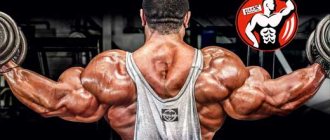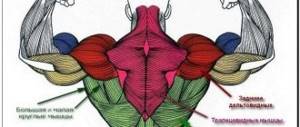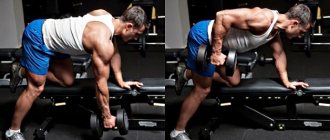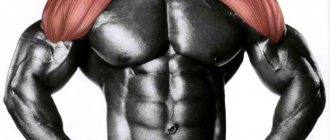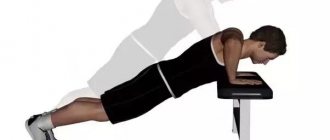Features of the shoulder structure
The shoulder joint connects the torso to the arms, allowing movement. The shoulder muscle frame strengthens and protects the joint. The shoulder is represented by the deltoid (thick triangular) muscle. Anatomically, it is involved in the extension (flexion) of the shoulder and ensuring the movement of the arm. It is divided into three bundles, each of which has its own function.
Table 1 - Functions of the muscle bundles of the shoulder
| Muscle bundle of the shoulder | Function |
| Front | Raising your arms forward, moving your elbows toward your body |
| Rear | Pulling your arms back |
| Lateral (middle) | Retraction of arms to the sides |
Each part of the deltoid muscles can be pumped separately or in combination. One-time shoulder training programs will not give the desired result. For optimal shoulder development, the load area should be distributed to all muscle sections.
The shoulder joints are fragile. For their development, a set of exercises has been developed, consisting of basic and isolated ones.
Number of approaches for shoulder training
You can see from the shoulder anatomy above that it is actually made up of 3 different small muscle groups. Many beginners treat the shoulder as one muscle group and train it like the chest: press, press, and press more.
The only problem with this training approach is that most of the shoulder mass will be gained in the anterior fascicle (front) and some mass in the middle and posterior fascicle (back) of the shoulder complex. This will cause terrible imbalance and can also lead to injury.
Without working on the middle and posterior deltoid muscles, the shoulders look narrow from all sides. Many times injury is the result of an imbalance such as this. Overall, the shoulder is a moderate-sized muscle, made up of three small muscles. Each muscle should receive the appropriate workload and nothing more.
The shoulder girdle can rotate almost 360 degrees and exercises will be performed in many different angles using weight machines, machines and cables. I like to use low reps (4-6) for compound pressing exercises and moderate reps (8-12) for isolation exercises.
All exercises must be performed with correct technique, because poor technique or bad exercise habits that you start now will follow you and lead to lack of progress or worse injury in the future. Many, if not all, of the exercises below will be new to you.
Now that you understand what muscles the shoulder is made of, its function, its location, and the number of sets required to strengthen them, let's give you some workouts that will help you build up your shoulders.
Barbell chest press (military press)
This exercise should be included in every workout. Mainly the anterior muscle bundles work.
Starting position (IP): feet wider than shoulders, head straight, grip of the apparatus wider than shoulders, focusing on chest level.
Technique:
- straightening your arms while exhaling upwards with elbows straightening;
- second delay;
- slowly return the barbell to the chest with the elbows slightly forward.
Adviсe:
- avoid deviations forward and backward;
- place the torso and upper limbs in the same plane;
- do not allow pauses at the lowest point;
- Do not move your shoulders in different directions, try not to spread your shoulder blades.
Some tips
Throw aside the baby dumbbells. Nothing will develop your traps like heavy barbell shrugs. Take a barbell, load it to the maximum and don’t be afraid to use cheating - this is the only way your traps will look like mountain peaks.
And don't rotate your shoulder joint, just lift the barbell up and down.
Seated dumbbell press
This exercise is familiar to everyone who has ever been to the gym. However, not many people follow the correct technique for performing it.
First of all, you should pay attention to the position of your hands: your elbows should look strictly to the sides, and your palms should face forward. The press occurs upward and inward, while the arms and torso are in the same plane
At the top point, the dumbbells should be brought together, but not pushed together. The reverse movement should be slow and controlled until your shoulders are parallel to the floor.
Pull-ups
Pull-ups are the best exercise for the upper body, but they are also quite challenging for beginners. If you haven't learned how to do pull-ups yet. you can replace it with a pull rod of the upper block. And if you can do more than 10-12 pull-ups per set, then it’s time to start using weights.
Seated block row
Many people underestimate this exercise, but it is this exercise that, as a counterweight to the bench press, will help you create a harmonious physique. Ideally, you should be able to lift the same amount of weight as you bench press, so don't be shy about pushing yourself harder.
If for some reason you don’t like the lat pulldown or you simply don’t have access to the right machine, you can replace it with a bent-over barbell row.
Bench press
This training exercise is considered one of the best for building muscle mass. The anterior and lateral muscle bundles are set in motion, which additionally creates a load on the triceps.
IP: sitting, the barbell is located on the shoulders a little wider than them. The chest is slightly forward, the shoulder blades are together, the limbs are firmly placed on the floor, the lower back is arched, the forearms are perpendicular to the ground in the lower position.
Technique:
- squeezing the barbell upward while exhaling until the arms are simultaneously straightened with a slight bend forward;
- lowering the projectile while inhaling into the IP (behind the head at eye level) at a slow pace.
The exercise can be performed while standing, but this increases the harmful load on the spine.
Tip : The press is done smoothly, slowly.
How to pump up deltoids. Best exercises
So. Now I will list the best, in my opinion, exercises for growing your deltoids, which have proven their effectiveness more than once.
Standing/seated barbell press (military press)
A great basic exercise that does a fantastic job of growing your shoulder girdle, but there are a few caveats.
The standing or seated barbell press should be performed in front of you (from the chest), and not from behind your head. I begin to understand what the herd instinct is when I see how people in the gym, one after another, begin to perform this exercise, winding the barbell by the head, simply copying each other. They also often perform a similar exercise in the Smith machine.
With this position of the shoulders (when the bar is placed behind the head), the shoulders take on an extremely uncomfortable position and the risk of injury greatly increases. Especially when people lower the bar too low, and even perform the exercise in full amplitude. Up, down, up, down... Grunt! Injury!
It is better to perform this exercise by lowering the barbell in front of you. It is more physiological and safe.
Another problem is that such an exercise can cause unpleasant sensations in the lower back, especially for beginners whose muscles in the lumbar region are very weak.
An alternative to the standing barbell press is the following exercise.
Seated dumbbell press exercise
The seated dumbbell press is an excellent alternative to the previous exercise for several reasons.
- Firstly, when you bench press, your wrists have nowhere to go, and they can be in a very uncomfortable position for them. When you press with dumbbells, your hands will automatically rotate into a more comfortable position for them, which will reduce the risk of injury.
- Secondly, during bench presses with dumbbells, many stabilizer muscles are activated, which fix the dumbbells in the hands relative to each other.
- Thirdly, due to the absence of a bar, the middle (hybrid) bundles of deltoid muscles are worked out much more strongly.
- Fourthly, because you are sitting, there is practically no axial load on the spine, so this exercise is suitable even for those who experience problems with the lower back.
Exercise: barbell row to the chin
The barbell chin row is a great basic exercise! The trouble is that such an exercise is very rarely performed correctly. Yes, what can I say. Almost never!
What is the problem? It’s just that traditionally, the upward movement, when we pull the barbell to the chin, begins for most with raising the shoulders. This is extremely unphysiological! Thus, the entire load falls on the shoulder joint.
It’s good when only the deltoids are contracted during this exercise, but it’s bad when the entire load falls on the shoulder joint, as when lifting the shoulders up.
What to do? You will have to greatly, almost completely change the technique of this exercise, so that in fact it will no longer be a barbell row to the chin.
Firstly, you need to pull towards your chest. And don’t raise your shoulders, secondly. You need to force yourself to keep your shoulders in place, but at the same time pull the barbell up, not to your chin, but to your chest. Up to your chest because this way your elbows will be lower than your shoulders. This is one of the basic rules.
Remember, in the barbell row to the chin: the elbows are always below the shoulders.
The deadlift is performed like this: take the barbell with a grip slightly wider than your shoulders, lean forward a little and, without raising your shoulders, lift the barbell to chest level (until your elbows are parallel to your shoulder joints). The narrower your grip, the more the trapezius is involved in the work and the greater the range of motion. And vice versa. A wider grip means the deltoids work more and the amplitude is smaller.
The barbell row to the chin mainly uses the middle bunch of our deltoids, which most visually makes the torso wider, and therefore is most noticeable for jocks.
In general, the front deltoid bundle works with all types of presses, so for most they are greatly hypertrophied, and the middle and rear deltoid bundles are underdeveloped. That's why many jocks seem stooped.
Solution: be sure to do rows to develop the middle and rear bundles of our shoulders, because this is their main function.
Side swing exercise with dumbbells
Side swings with dumbbells are isolating exercises, i.e. exercises that involve only one joint (in this case, the shoulder). I must say that in the first year of training there is no point in doing swings at all for a beginner, because... the muscles will be able to handle the load from bench presses and rows.
Swings are usually needed in two cases:
- if you want to “finish off” your deltoids with targeted load after the main workout;
- if you want to pre-warm up and pump blood into the deltas before the main workout;
There are different types of swings, but they can all be divided into three main groups:
- front;
- middle (to the sides);
- rear (inclined);
Raising dumbbells in front of you will target your front deltoids. As a rule, there is no need for this, because... The front deltoids are heavily loaded in various other presses (bench press, etc.). If you still think you need to do front swings, use high reps with light dumbbells, or take one heavy dumbbell and lift it in front of you.
To properly load the middle bundles of the deltoid muscles, you need to use dumbbell swings to the sides (across the sides).
They need to be performed like this: lean forward slightly, lower your shoulders down to turn off the trapezius from work, try to lift the dumbbells so that your elbows are slightly higher than your wrists.
There is one trick. To understand how to do side swings, you need to imagine that you are holding a cup in your hands and pouring water out of them. Then your wrists will rotate correctly (little finger on top and thumb on bottom). This will work great on the middle fascicles of your deltoids.
The posterior bundles, as a rule, are the most stubborn, but this is most likely due to the fact that the technique of performing the exercise is lame. In fact, there is nothing complicated. Just lean forward a little more (almost to a horizontal position). The technique is like two peas in a pod and is similar to the technique for medium buns.
The posterior bundles are traction muscles. Therefore, they grow well when performing barbell rows to the chin with a much stronger forward tilt of the body (almost 90 degrees). Swings are performed in the same position.
Another alternative is the Lee Haney behind-the-back deadlift. It was invented, as you understand, by the cool bodybuilder Lee Haney, who won the Olympia 8 times, but that’s not the point.
Usually, it is performed either with a barbell behind the back or in a Smith, but there is a problem. Your ass is in the way! Not very comfortable.
Lee Haney's behind-the-back row is similar to a shrug (shrug), but here the elbow joint is still bent at the top point. Alternatively, you can perform deadlifts with dumbbells instead of a barbell. Raise them alternately to stabilize the body and concentrate on the rear bundle of our deltoids.
If I were specifically asked: “How to pump up deltoids?”, then I would describe a POWERFUL training program for shoulders this way:
- Seated dumbbell press: size 2 + 3-4 x 6-12.
- Barbell row to the chin: 1 size + 3-4 x 6-12.
If you have been training for a long time, you can add dumbbell swings at the end to “finish off” your deltoids:
- Dumbbell swings: 1 size + 3-4 x 8-12.
If you, like most people, are lagging in the back of your deltoids, then bend forward a little stronger, replacing the usual swings with dumbbell swings in a tilted position:
- Bent-over dumbbell swings: 1 size + 3-4 x 8-12.
EZ-bar row to the chin area
The load during this traction is carried out on the area of the middle deltas. The exercise helps relieve excessive stress from the wrists, thanks to their natural position, which ensures the curvature of the barbell.
IP: standing straight, the barbell in front on extended lowered arms, slightly bent at the elbows, feet shoulder-width apart.
Technique:
- lifting the projectile up to the chin while bending your elbows, exhale;
- after a second delay, slow return of the bar to the IP while inhaling.
Instead of an EZ bar, you can use a regular bar.
Adviсe:
- forearms do not rise above the shoulders, only to a parallel position with the floor (or slightly higher);
- when moving upward, breathing should be held;
- Do not raise your hands above your elbows;
- place your elbows further from the body;
- Do not shift the center of gravity to the toe to avoid loss of balance.
Each of the exercises requires cleanliness and correct technique.
Standing raises with dumbbells
The anterior and middle muscle bundles work.
IP: stand up straight, place your feet shoulder-width apart with your toes pointing to the sides, take the shells with your palms inward in your straight arms.
Technique:
- lifting dumbbells to the sides until your shoulders and arms create a single line parallel to the floor (there is no task of raising the weights higher), arms are slightly bent at the elbows;
- after a quick rise, slowly lower your arms into the IP while exhaling.
It is possible to perform the exercise in a block alternately with the left and right hand.
Adviсe:
- elbows turn towards the ceiling, thumbs below little fingers;
- do not sway, maintaining balance;
- effectiveness is lost with excessive weight;
- arms need to be raised only to the horizontal, without moving to the vertical;
- monitor correct breathing, holding air serves as support for the spine;
- the back is straight;
- When lifting, you can bend your elbows.
Dumbbell lateral raises on an incline bench
IP: lying down, face down on the bench, arms with the apparatus in front slightly bent, fingers resting on the floor.
Technique:
- raising your arms up through the sides until your shoulders and floor are parallel, exhale;
- slowly lower the arms while maintaining muscle tension in the IP, inhale.
Advice: try to bring your shoulder blades together
Seated dumbbell press
This exercise is convenient for training at home.
IP: sitting on a bench (back angle 80-90°), place dumbbells at eye level with elbows turned to the sides. The position of the forearms is vertical, the lower back is arched, the feet are firmly placed on the floor.
Technique:
- powerful squeezing of dumbbells with a slight connection above the head, exhale;
- delay of several seconds;
- smooth return to IP, inhale.
Adviсe:
- make hand movements in a single plane, do not straighten them sharply;
- bring projectiles overhead;
- do not bend, do not lean back.
Arnold press
The anterior and middle deltoid bundles are worked on. The press is difficult, but effective. It differs from a regular bench press in the presence of torque.
IP: sitting on a bench with a backrest at 90°, pressed tightly, with dumbbells in your hands at neck level. The palms are turned towards you, the legs are placed wide apart at a right angle.
Technique:
- while holding your breath, straighten your arms vertically as high as possible;
- when your elbows reach your chin, turn your wrists 180 degrees, exhale;
- with the same rotation, but in the opposite direction, slowly lowering the projectiles along the same trajectory, inhale.
What adds popularity is the name of the person who regularly used it.
Adviсe:
- use lighter weight equipment than in other exercises;
- ensure a slow pace, proper breathing;
- Do not straighten your elbows completely at the extreme point.
Raising dumbbells in front of you
The main load is distributed to the front bundles.
IP: standing, arms lowered with shells forward in front of the hips, palms facing you, arms slightly bent.
Technique:
- raising your arms, slightly bent at the elbows, in front of you alternately until your shoulders are parallel to the floor.
Adviсe:
- do not lift the equipment with a jerk;
- try not to rock the body,
- keep your elbows as motionless as possible.
Isolation exercises, which involve only one muscle group, are important for additional muscle development.
Back muscle training program for weight in the gym
Back exercises are often done on the same day as chest training. Start your workout with your back muscles, as this muscle group is larger. But if your chest muscles are lagging behind, then do them first, when you have more strength.
Pull-ups
video - Pull-ups and barbell rows
Features of the technique:
- by changing the width of the grip, you can work on different areas of the back: the wider the grip, the more the lats are involved in the work, making the back wide;
- pull yourself up using the muscles of your back, not your arms - the biceps are included in the work only at the top point;
- Don't pull your shoulders towards your ears.
If you weigh little and it’s easy to pull yourself up, use a weight – a belt with a weight plate. If, on the contrary, you still can’t pull yourself up, then put the chair down and push off from it with one leg. In the gym, you can do pull-ups on a special “Graviton” simulator (the greater the weight of the counterweight, the easier it is to do pull-ups; start with a counterweight slightly lighter than your own weight).
Deadlift
video - deadlift
The deadlift is the best, but at the same time the most traumatic back exercise. The deadlift is indispensable when working on weight. The main thing is to master the correct technique and not rush to hang more weights on the barbell. To protect yourself from injury: pump up your abdominal muscles and spinal erectors. They will support the spine during the deadlift. Auxiliary exercises: hyperextension, abdominal crunches.
Deadlift Variations:
Bent-over barbell row
video - Bent-over barbell row
Bent-over barbell rows help build mass in the latissimus and trapezius dorsi muscles; this exercise should definitely be included in your mass program. All of the Deadlift tips apply to the Bent Over Row as well - master the technique and strengthen the supporting muscles before adding more weight to the barbell.
Features of the technique:
- legs slightly bent at the knees;
- back at an angle of 45%;
- spine in one straight line;
- pull the barbell to the lower abdomen, not to the chest;
- the bar slides over your thighs.
One-arm dumbbell row
video - one-arm dumbbell row
The one-arm dumbbell row is a great alternative to the bent-over barbell row. Do this exercise longer (first with one hand, then with the other), but you can work with a greater amplitude (the muscles will stretch and contract stronger). Those. you can only lift the barbell up to your stomach, and pull the dumbbell higher. Due to this, the back muscles are better “pumped”.
Features of the technique:
back parallel to the bench; pull the dumbbell with your back muscles first, the biceps are activated only at the end: you pump your back, not your arms! at the top point of the exercise, the body does not need to be turned (the back remains parallel to the bench), it is important to feel the contraction of the back muscles.
T-row on the machine
video - T bar row technique
T-row on the machine works the lats and minimizes the load on the spine
. This is necessary for those who cannot perform basic exercises with free weights due to injuries or want to “finish off” the lats after the basics without overloading the spine.
Upper block pull
video - Technique lat pulldown
The lat pull-down is an auxiliary back exercise for those who do not yet know how to do pull-ups.
Lower block thrust
video - Lower pull-down technique
The lower block row is an alternative to the bent-over barbell row; you can put it at the end of the workout to “finish off” the back muscles.
Hyperextension
video - Hyperextension technique
Hyperextension is a great exercise for the spinal erectors. It can be done either with additional weight (barbell or plate) or without.
Features of the technique:
- the hips lie on pillows in front;
- the hip bones are at the leading edge of the pads. If you move your pelvis 10 cm higher, your legs and gluteal muscles will receive more load;
- the back does not round when performing the exercise, it remains straight;
- When rising from the bottom point, the back does not hyperextend; it should be in line with the legs.
Features of organizing training
Before any workout, you need to warm up, “warm up” your muscles and joints. This is a kind of prevention of widespread shoulder injuries. A set of swings and circular movements of the arms is optimal. After which you should start training directly.
First, 1-2 exercises of the basic direction are performed, after which isolating exercises for certain muscle bundles are performed. Presses are considered particularly effective. To achieve results, regular exercise combined with proper nutrition is important.
Training can be carried out both in the gym and at home if you have dumbbells and barbells. Beginners should first master one or two basic presses to evenly work the shoulder. If he is sufficiently trained, gradually add isolation exercises.
An indicator of masculinity - broad shoulders - can be found not only in versions of artists and sculptors, but also in everyday life. Proper combinations of base and insulating components will help achieve ideal proportions.
Back and biceps workout in one day
The most productive and effective training allows you to achieve your goal. There is no universal single system that suits everyone and has no exceptions. Each athlete has his own characteristics and results that he expects from a particular program. And in order to achieve the desired goal, of course, you need to listen to the recommendations and basic principles of constructing the training process, but make adjustments, focusing on constant progress and reducing the risks of injury and overtraining.
Working on these muscle groups in one training day allows you to increase the effectiveness of working out your back and biceps. This allows you to make the most of your time in the gym. Working out your biceps and back in one session allows you to stimulate active growth of muscle mass and increase strength. A small adjustment to your usual workout routine can help you do this. You need to start the lesson with light cardio, performed for a few minutes, and only then move on to the main program.
